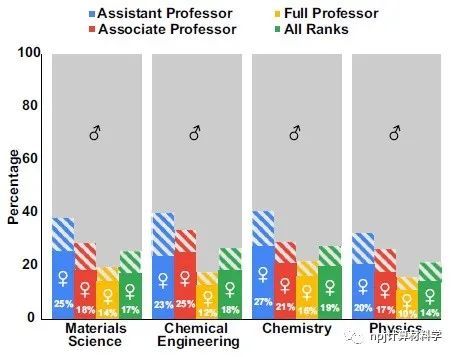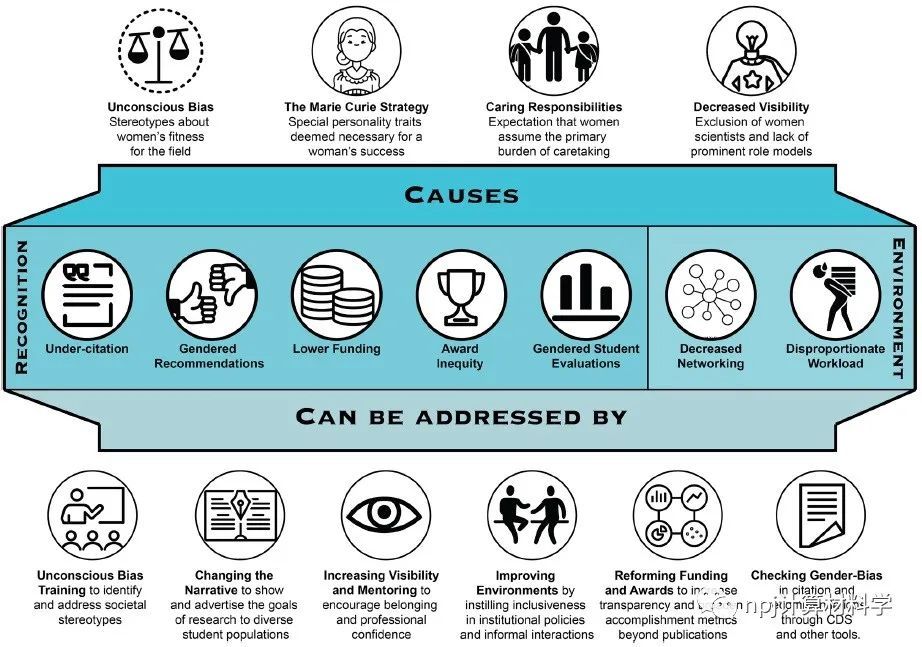在近代历史上,人们对性别平等的态度有了相当大的改善。然而,由于职业发展、对女性的认识和认知等方面仍存在系统性偏见,不平等在许多领域仍然存在,这也包括计算材料研究子领域。解决公平方面的问题符合所有人的利益。针对科学研究,包容性是至关重要的,这不仅是从伦理的角度来看,而且对于吸引和留住敬业和有才华的头脑、增强领域的活力、培养各种各样的思维都是如此。
代表和思维的多样性可以提高一个人类的集体智慧,提高生产力,并提高我们计算材料研究者在该领域得持续性。此外,代表全体民众对于确保科学对社会需求负责和相关也是必要的。

Fig. 1 Trends in the percentage of undergraduate and graduate degrees awarded to women in the United States of America, National Center for Education Statistics5.
Arrow widths are proportional to the rate of increase. Trendlines were determined through regularized linear regression.
来自英国华威大学化学系的Livia B. Pártay等,通过对文献数据的引用和分析,回顾了当前女性在科学领域面临的挑战和障碍。根据美国教育统计中心报告,特别是美国学术机构按学科和性别颁发的学位数量,在过去30年里,授予女性研究生学位的比例在所有领域都得到稳步上升,但科学、技术、工程和数学(STEM)学科的男女本科生之间的差距仍然很大。

Fig. 2 Percentages of female faculty across ranks, as reported by the Academic Analytics Research Center .
Striped bars indicate faculty of unknown gender. Here we use the American-style professorial ranks, where an “assistant” professor refers to a pre-tenure junior professor, an “associate” professor refers to a post-tenure mid-level professor, and a “full” professor refers to a senior-level tenured professor.
造成女性在STEM环境中面临的障碍通常可以总结为:无意识偏见,关于女性适合这个领域的刻板印象;居里夫人策略,被认为是女性成功所必需的特殊人格特质;关怀的责任,期望女性承担照顾孩子的主要负担;知名度低,排斥女科学家,缺乏杰出的榜样。这些偏差和障碍可以通过一系列不同的测量方式表现出来:从认知方面来说,论文引用率低、推荐信短、较低的资金、奖项不平等、学生评价;从工作环境来说,较少的交际机会、不成比例的工作量。

Fig. 3 A Summary of gender inequity causes, manifestations, and responses.
Many of these phenomena are interrelated, and it is important to take a multi-pronged approach to addressing the causes and manifestations of these inequities. Individual images obtained through the Noun Project (thenounproject.com).
解决障碍最重要的就是承认偏见的存在,然后采取实际行动,如无意识偏见识别和解决社会刻板印象的培训;改变检查性别偏见的叙述,向不同的学生群体展示和宣传研究目标;增加知名度和指导,以鼓励归属感和专业信心;通过在体制政策和非正式互动中灌输包容性来改善环境;改革资金和奖励制度,以提高透明度,并将成就衡量标准扩大到出版物之外;通过引用多样性声明和其他工具检查引文和推荐中的性别偏见。
本篇论文对计算材料研究领域中的性别不平等进行了总结,希望可以提高科学界的认识,并推动学术界走向更公平的环境。该文近期发布于npj Computational Materials 9: 98 (2023)。

Fig. 4 Usage of artificial intelligence. Would you use an AI tool to create graphics for your presentation or visual communications?
Four computational materials scientists having a research discussion, as imagined by the AI tool images.ai, only depicts older white men.
Editorial Summary
The unequal treatment faced by women in computational materials researchWhile attitudes on gender equity and parity have considerably improved in recent history, there are still measurable inequities stemming from systemic bias in the career progression, recognition, and perception of women in the sciences, including our sub-field of computational materials research.
Addressing the obstacles to equity is in everyone’s interest. Making research inclusive is critical, not only from an ethical standpoint, but also for attracting and retaining dedicated and talented minds, enhancing the vibrancy of all fields, and nurturing a diverse range of ideas.
Diversity in representation and thought can increase a group’s collective intelligence, improve productivity, and improve retention in growing fields such as ours. Representation of the entire populace is also necessary for ensuring that science is responsible and relevant to societal needs.
In a perspective, Livia B. Pártay et al. from the Department of Chemistry at the University of Warwick, UK, reviewed the current challenges and barriers for women in science, citing data and analysis from the literature. Based on the number of degrees awarded by subject and gender by US academic institutions reported by the US Department of Education National Center for Education Statistics (NCES), the authors demonstrated that the proportion of graduate degrees awarded to women has steadily increased in all fields over the past 30 years, but the gap between male and female undergraduates in science, technology, engineering, and mathematics (STEM) disciplines often still looms large.
The barriers that women face in STEM environments can often be summed up as: Unconscious biases- stereotypes about women’s fitness for the field, the Marie Curie Strategy-special personality traits deemed necessary for a woman’s success, Caring Responsibilities-expectation that woman assume the primary burden of caretaking, Decreased Visibility-exclusion of woman scientists and lack of prominent role models.
These biases and barriers can be measured in a range of different ways, from a cognitive perspective, such as low citation rates, short letters of recommendation, lower funding, award inequality, gendered student evaluations, in terms of the working environment, decreased networking opportunities, disproportionate workload.
The first step in addressing the barriers is to acknowledge the existence of bias and then take practical action, such as unconscious bias training to identify and address social stereotypes, changing the narrative to show and advertise the goals of research to diverse student populations, improving visibility and mentoring to encourage belonging and professional confidence, improving environments by installing inclusiveness in institutional policies and informal interactions, reforming funding and awards to increase transparency and broaden accomplishment metrics beyond publications, checking gender-bias in citations and recommendations through Citation Diversity Statement (CDS) and other tools.
This paper summarizes the gender inequality in the field of computational materials research, hoping to raise awareness in the scientific community and move academia towards a more equitable environment. This article was recently published in npj Computational Materials 9, 98 (2023).
原文文题、作者
Not yet defect-free: the current landscape for women in computational materials research (尚不完美:计算材料研究中女性的现状)Livia B. Pártay, Erin G. Teich & Rose K. Cersonsky
























 3万+
3万+











 被折叠的 条评论
为什么被折叠?
被折叠的 条评论
为什么被折叠?








